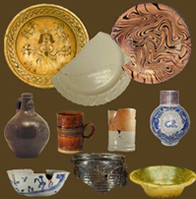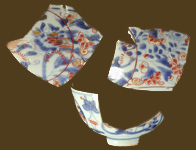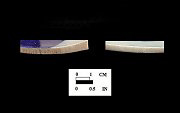
|
|
Porcelain Defining Attributes Chinese porcelain has a vitrified, glassy paste with a slight blue to pale gray tint that blends into and is nearly indistinguishable from the glaze. English porcelain, from the 18th century, has a somewhat softer, slightly translucent, paste and a clear, semi-gloss glaze that frequently appears distinct from the body. Chronology Chinese porcelain from the Ming Dynasty (1364 – 1644) was introduced into Europe in the mid-16th century, initially by the Portuguese and then more extensively by the Dutch. Porcelain is very rare on archaeological sites in the Chesapeake dating to the 17th century. Delicate blue painted, white-bodied Ming sherds are found in contexts from the first half of the 17th century. A coarser ware, Kraak porcelain, was manufactured especially for export and is also found on early 17th century sites in the Chesapeake region (Curtis 1988; Sperling and Galke 2001). Chinese porcelain became inaccessible to Europeans during the mid 17th century due to internal wars in southern China. The Dutch imported Japanese Imari porcelain in its place after 1650, and occasional fragments of this ware are found on colonial sites (Mudge 1986:33-34, 87). By the end of the 17th century, Chinese porcelain was again traded to Europe, in the ubiquitous ‘blue and white’ and also overglaze enameled. This Chinese Export porcelain was specifically made for the European market. Common decorative motifs included floral, foliate, waterscapes, Chinese houses, people, birds, insects, and geometric and crosshatched borders. In the 18th century, these motifs were much copied by English potters, while the Chinese were copying many European engravings and paintings, so that at times it is difficult to determine the actual origin of a particular pattern. Through a systematic study of decorations found on marked porcelain vessels, Andrew Madsen (1995) was able to document and define date ranges for certain types of decorative motifs. This information has been recently published in George Miller's article on dateable artifacts (2002) Blue underglaze painted porcelain was the most common import in the colonies, and far exceeds the amount of overglaze ware found on archaeological sites (Noël Hume 1970:261). Chinese Export porcelain in imitation of the Japanese Imari style is found on sites dating from 1700 - 1760 (Madsen 1995:106-108). In addition to the Imari style motifs, two additional overglaze enamel palettes were made: famille verte (1690 – 1730) and famille rose (1720 – 1800) (Madsen 1995:103-105). Some tea wares and bowls are found with a brown exterior surface and are referred to as Batavian ware. These vessels appear to date to ca. 1740 – 1780 (Miller and Stone 1970; Noël Hume 1970:259-260). English soft paste porcelain was first successfully made around 1742, and is found on sites in the Chesapeake region dating to the second half of the 18th century (Noël Hume 1970). Archaeological investigations at the early English porcelain factories in Bow, Worcester, Liverpool, and Caughley provide information on dating the various soft paste varieties and decorative motifs (Cushion and Cushion 1992). Experimentation to produce porcelain in America occured late in the 18th century in Philadelphia by Gouse Bonnin and George Anthony Morris (Noel Hume 1970:100), though their production was very small. Description Fabric Glaze The clear semi-gloss glaze on English soft paste porcelains is made from various recipes, some even including a bit of tin, and does not fuse with the paste. The glaze can be seen in cross-section as a thin white line along each surface, and often exhibits surface deterioration. Chinese and Japanese porcelains can sometimes be distinguished from each other by the tint of the glaze. Japanese glazes tend to be a flat white or grayish white, while there is often a faint bluish tint to the Chinese porcelain glaze (Deagan 1987:103). Decoration The overglaze colors and gilding tend to become unstable when buried in the ground, and will cling more to the dirt than to the porcelain. Often the overglaze colors are totally gone, and the fugitive designs can only be seen when a sherd is held in the light at an angle. English wares were decorated in underglaze blue, overglaze enamels, and overglaze transfer printed patterns. Overglaze enamels were often added to a transfer printed design. Decorated Chinese porcelain from colonial archaeological sites is always hand painted. The vast majority of exported Chinese porcelain is unmarked, though occasionally dynasty marks are found. Studies of decorated vessels with marks provide some dating information for various motifs, especially for 18th century wares (Curtis 1988; Cushion and Cushion 1992; Madsen 1999). A common characteristic of 17th century Kraak porcelain is the lingzhi, or sacred fungus, mark found on the back of vessels. A Kraak sherd found at 18ST233, a ca. 1637 – 1650s site in St. Inigoes Maryland, has one of these marks (Sperling and Galke 2001). Form Kraak porcelain was made in four general form categories: dishes, klaptmutsen, bowls, and closed forms such as bottles, wine pots, and covered boxes. Klaptmutsen are deep dishes or bowls with flattened rims, possibly influenced by Dutch forms (Rinaldi 1989:70-191). Footings are often rough from sand scars due to the practice of firing Kraak porcelain on a bed of sand (Rinaldi 1989:66). References Curtis 1988; Cushion and Cushion 1992; Deagan 1987; Madsen 1995; Miller 2002; Mudge 1986; Noël Hume 1970, 1994, 2001; Rinaldi 1989; Sperling and Galke 2001.
|
|

|
Thank you for visiting our website. If you have any
questions, comments, Copyright © 2002 by |

|


